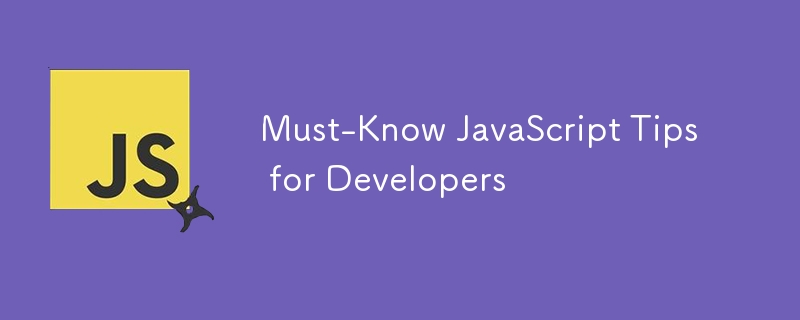

Use Object.entries() to loop through key-value pairs.
const person = {
name: 'Tony Stark',
age: 53,
city: 'NewYork'
};
/*
name: Tony Stark
age: 53
city: NewYork
*/
for (const [key, value] of Object.entries(person)) {
console.log(`${key}: ${value}`);
}
Explanation:
Use filter(Boolean) to filter out falsy values.
(Falsy values includes false, 0, '', null, undefined, and NaN)
const arr = [1, 2, 0, '', undefined, null, 3, NaN, false]; const filteredArr = arr.filter(Boolean); console.log(filteredArr); // [1, 2, 3]
Explanation:
Use the flat() method to flatten arrays.
const multiDimensionalArray = [[1, 2], [3, 4, [5, 6]]]; const flattenedArray = multiDimensionalArray.flat(2); // Output: [1, 2, 3, 4, 5, 6] console.log(flattenedArray);
Explanation:
Use Array.from() to create an array from iterables.
// Converting String to an array const str = "TonyStark"; const arr = Array.from(str); // ['T', 'o', 'n', 'y', 'S', 't', 'a', 'r', 'k'] console.log(arr);
// Converting Set to an array const set = new Set([1, 2, 3, 3, 4, 5]); const arr = Array.from(set); console.log(arr); // Output: [1, 2, 3, 4, 5]
Explanation:
Use destructuring to extract values from an array.
const numbers = [1, 2, 3, 4, 5]; const [first, second, , fourth] = numbers; console.log(first); // 1 console.log(second); // 2 console.log(fourth); // 4
Explanation:
Use object destructuring to extract properties.
const person = {
name: 'Tony Stark',
age: 53,
email: 'tonystark@starkindustries.com'
};
const {name, age, email} = person;
console.log(name); // Tony Stark
console.log(age); // 53
console.log(email); // tonystark@starkindustries.com
Explanation:
Promise.all() allows multiple promises to be executed in parallel.
const promise1 = fetch('https://api.example.com/data1');
const promise2 = fetch('https://api.example.com/data2');
Promise.all([promise1, promise2])
.then(responses => {
// handle responses from both requests here
const [response1, response2] = responses;
// do something with the responses
})
.catch(error => {
// handle errors from either request here
console.error(error);
});
Explanation:
Use Math.max() and Math.min() with spread syntax.
const nums = [10, 12, 29, 60, 22]; console.log(Math.max(...nums)); // 60 console.log(Math.min(...nums)); // 10
Explanation:
Use double negation !! to convert values.
!!2; // true !!''; // false !!NaN; // false !!'word'; // true !!undefined; // false
Explanation:
Use array destructuring to swap values.
let a = 5; let b = 10; // Swap values using array destructuring [a, b] = [b, a]; console.log(a); // 10 console.log(b); // 5
Explanation:
The above is the detailed content of Must-Know JavaScript Tips for Developers. For more information, please follow other related articles on the PHP Chinese website!
 formatter function usage
formatter function usage
 How to check ports in Linux
How to check ports in Linux
 How to deal with slow computer lag and slow response
How to deal with slow computer lag and slow response
 What should I do if my C drive turns red?
What should I do if my C drive turns red?
 What are the configuration management tools?
What are the configuration management tools?
 How do PR subtitles appear word for word?
How do PR subtitles appear word for word?
 How to configure default gateway
How to configure default gateway
 What are the IP reverse domain name checking tools?
What are the IP reverse domain name checking tools?




